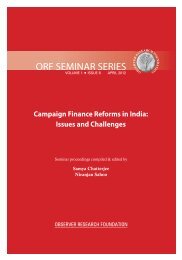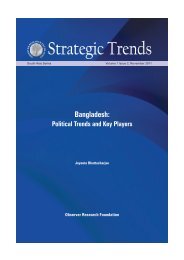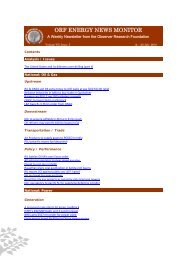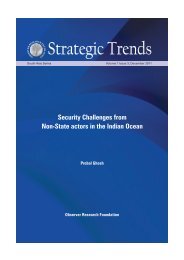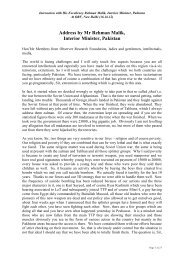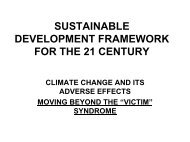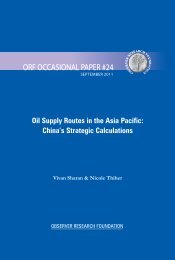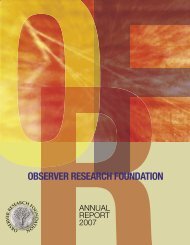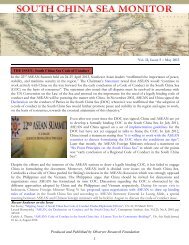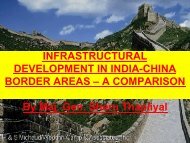Affirmative Action in Private Sector in Malaysia - Observer Research ...
Affirmative Action in Private Sector in Malaysia - Observer Research ...
Affirmative Action in Private Sector in Malaysia - Observer Research ...
You also want an ePaper? Increase the reach of your titles
YUMPU automatically turns print PDFs into web optimized ePapers that Google loves.
technical, adm<strong>in</strong>istrative and managerial occupations as well as high <strong>in</strong>come clerical and<br />
sales jobs). Both <strong>in</strong> adm<strong>in</strong>istrative and managerial jobs, it is still the Ch<strong>in</strong>ese who dom<strong>in</strong>ate.<br />
Nevertheless, this is significant achievement compare to their situation immediately after the<br />
<strong>in</strong>dependence which has brought <strong>in</strong> a grow<strong>in</strong>g Malay middle class which was non-existent <strong>in</strong><br />
the pre-NEP era.<br />
Table 2. Registered professionals by ethnicity (Percentage of total)<br />
Year Bumiputera Ch<strong>in</strong>ese Indian Other Total<br />
1970 4.9 61.0 23.3 10.8 100.0<br />
1985 22.2 61.2 13.9 2.7 100.0<br />
1999 28.9 53.9 15.5 1.7 100.0<br />
2005 38.8 48.7 10.6 1.9 100.0<br />
Source: 8 th & 9 th <strong>Malaysia</strong> Plan.<br />
Table-3, N<strong>in</strong>e major professional occupations<br />
Occupational<br />
Categories 1990 2000 2005<br />
Bumi Ch<strong>in</strong>ese Indians Bumi Ch<strong>in</strong>ese Indians Bumi Ch<strong>in</strong>ese Indians<br />
Professional &<br />
technical 10.0% 7.8% 7.9% 19.7% 18.2% 18.6% 20.7% 18.5% 20.1%<br />
Mm<strong>in</strong>us teachers<br />
and nurses 5.7% 5.3% 5.4% 14.9% 15.7% 15.9% 15.8% 15.9% 17.2%<br />
Teachers and<br />
nurses 4.3% 2.5% 2.5% 4.8% 2.5% 2.7% 4.9% 2.6% 2.9%<br />
Adm<strong>in</strong>istrative &<br />
managerial 1.3% 4.7% 1.1% 4.8% 12.7% 5.4% 5.4% 14.0% 6.3%<br />
Clerical 9.7% 11.6% 9.8% 10.3% 11.2% 8.4% 10.6% 11.2% 9.6%<br />
Sales & service 19.2% 30.2% 22.1% 12.7% 17.5% 11.2% 14.0% 18.8% 13.3%<br />
Agri workers 37.0% 12.0% 24.2% 18.9% 5.9% 8.3% 15.2% 3.7% 4.9%<br />
Production<br />
workers 22.8% 33.6% 34.9% 33.6% 34.5% 48.1% 34.1% 33.8% 45.8%<br />
100% 100% 100% 100% 100% 100% 100% 100% 100%<br />
Source: 8 th & 9 th <strong>Malaysia</strong>n Plan.<br />
Another key objective of the NEP was to create Bumiputera Commercial and Industrial<br />
Community (BCIC). How much was achieved <strong>in</strong> those 20 years (1970-90)? Except for small<br />
islands of excellence, by all accounts this scheme to create Bumiputera entrepreneurs is a<br />
grand failure. A vast majority of those Bumiputera entrepreneurs that operate and claim to be<br />
successful are largely because of their close political connection and liberal access to<br />
patronage system (Samad, 2003). Yet, despite grand failures <strong>in</strong> several areas, the NEP did<br />
create some real entrepreneurs even if their numbers may be very small. The preferential<br />
treatments (loans, contracts, concessions, and scholarships) have accelerated social mobility<br />
among Malays, created a pool of Malay entrepreneurs, and expanded the Malay middle class<br />
(Crouch, 1996; Jesudason, 2001; Jomo, 1986). All of them were not rentiers liv<strong>in</strong>g off their<br />
political connections. A review of <strong>Malaysia</strong>’s contemporary bus<strong>in</strong>ess elite would reveal that<br />
presence of a significant number of Malay bus<strong>in</strong>ess people who actively participate <strong>in</strong><br />
runn<strong>in</strong>g their bus<strong>in</strong>esses (Searle 1999). Fact is majority of them obta<strong>in</strong>ed their first



